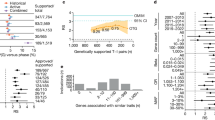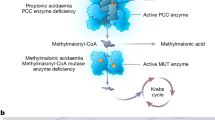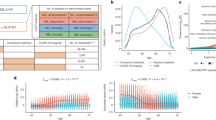Abstract
ACTIVATED protein C (APC) is a serine protease with potent anti-coagulant properties, which is formed in blood on the endothelium from an inactive precursor1. During normal haemostasis, APC limits clot formation by proteolytic inactivation of factors Va and Villa (ref. 2). To do this efficiently the enzyme needs a non-enzymatic cofactor, protein S (ref. 3). Recently it was found that the anticoagulant response to APC (APC resistance) 4 was very weak in the plasma of 21% of unselected consecutive patients with thrombosis5 and about 50% of selected patients with a personal or family history of thrombosis6,7; moreover, 5% of healthy indi-viduals show APC resistance, which is associated with a sevenfold increase in the risk for deep vein thrombosis5. Here we demonstrate that the phenotype of APC resistance is associated with hetero-zygosity or homozygosity for a single point mutation in the factor V gene (at nucleotide position 1,691, G→A substitution) which predicts the synthesis of a factor V molecule (FV Q506, or FV Leiden) that is not properly inactivated by APC. The allelic fre-quency of the mutation in the Dutch population is ∼2% and is at least tenfold higher than that of all other known genetic risk factors for thrombosis (protein C (ref. 8), protein S (ref. 9), antithrombin10 deficiency) together.
This is a preview of subscription content, access via your institution
Access options
Subscribe to this journal
Receive 51 print issues and online access
$199.00 per year
only $3.90 per issue
Buy this article
- Purchase on Springer Link
- Instant access to full article PDF
Prices may be subject to local taxes which are calculated during checkout
Similar content being viewed by others
References
Esmon, C. T. Arteriosclerosis and Thrombosis 12, 135–145 (1992).
Walker, F. J. & Fay P. J. FASEB J. 6, 2561–2567 (1992).
Walker, F. J. J. biol. chem. 255, 5521–5524 (1980).
Dahlbäck, B., Carlsson, M. & Svensson, P. J. Proc. natn. Acad. Sci. U.S.A. 90, 1004–1008 (1993).
Koster, T. et al. Lancet 342, 1503–1506 (1993).
Svensson, P. J. & Dahlbäck, B. New Engl. J. Med. 300, 517–522 (1994).
Griffin, J. H., Evatt, B., Wideman, C. & Fernandez, J. A. Blood 82, 1989–1993 (1993).
Allaart, C. F. et al. Lancet 341, 134–138 (1993).
Engesser, L., Broekmans, A. W., Briët, E., Brommer, E. J. P. & Bertina, R. M. Ann. int. Med. 106, 677–682 (1987).
Hirsh, J., Piovella, F. & Pini, M. Am. J. Med. 87, 345–385 (1989).
Dahlbäck, B & Hildebrand, B. Proc. natn. Acad. Sci. U.S.A. 91, 1396–1400 (1994).
Wang, H., Riddell, D. C., Quinto, E. R., MacGillivray, R. T. A. & Hamerton, J. L. Genomics 2, 324–328 (1988).
Jenny, R. J. et al. Proc. natn. Acad. Sci. U.S.A. 84, 4846–4850 (1987).
Kane, W. H. & Davie, E. W. Proc. natn. Acad. Sci. U.S.A. 83, 6800–6804 (1986).
Kane, W. H., Ichinose, A., Hagen, F. S. & Davie, E. W. Biochemistry 26, 6508–6514 (1987).
Cripe, L. D., Moor, K. D. & Kane, W. H. Biochemistry 31, 3777–3785 (1992).
Shen, N. L. L. et al. J. Immun. 150, 2992–3001 (1993).
Walker, F. J., Scandella, D. & Fay, P. J. J. biol. Chem. 265, 1484–1489 (1990).
Walker, F. J. & Fay, P. J. J. biol. Chem. 265, 1834–1836 (1990).
Odegaard, B. & Mann, K. J. biol. Chem. 262, 11233–11238 (1987).
Suzuki, K., Dahlbäck, B & Stenflo, J. J. biol. Chem. 257, 6556–6564 (1982).
Monkovic, D. D. & Tracey, P. B. Biochemistry 29, 1118–1128 (1990).
Yang, X. J. et al. Biochem. J. 272, 399–406 (1990).
Triglia, T., Peterson, M. G. & Kemp, D. J. Nucleic Acids Res. 16, 8186 (1988).
NIH/CEPH Collaborative Mapping Group Science 258, 67–86 (1992).
Guinto E. R., Esmon C. T., Mann K. G. & MacGillivray R. T. A. J. biol. Chem. 267, 2971–2978 (1992).
Pieters, J. & Lindhout, T. Blood 72, 2048–2052 (1988).
Chromczynski, P. & Sacchi, N. Analyt. Biochem. 162, 156–159 (1987).
Reitsma, P. H., Poort, S. R., Allaart, C. F., Briëf, E. & Bertina, R. M. Blood 78, 890–984 (1991).
Verduyn, W. et al. Hum. Immun. 37, 59–67 (1993).
Author information
Authors and Affiliations
Rights and permissions
About this article
Cite this article
Bertina, R., Koeleman, B., Koster, T. et al. Mutation in blood coagulation factor V associated with resistance to activated protein C. Nature 369, 64–67 (1994). https://doi.org/10.1038/369064a0
Received:
Accepted:
Issue Date:
DOI: https://doi.org/10.1038/369064a0
This article is cited by
-
Evaluation of prothrombotic risk of two PROC hotspot mutations (Arg189Trp and Lys193del) in Chinese population: a retrospective study
Thrombosis Journal (2023)
-
Identifying individuals at extreme risk of venous thromboembolism using polygenic risk scores
Nature Genetics (2023)
-
Thrombophilia testing in splanchnic venous thrombosis: Decoding a conundrum
Indian Journal of Gastroenterology (2023)
-
The prognostic role of extended preoperative hypercoagulability work-up in high-risk microsurgical free flaps: a single-center retrospective case series of patients with heterozygotic factor V Leiden thrombophilia
BMC Surgery (2022)
-
Integrative analyses of genes related to femoral head osteonecrosis: an umbrella review of systematic reviews and meta-analyses of observational studies
Journal of Orthopaedic Surgery and Research (2022)
Comments
By submitting a comment you agree to abide by our Terms and Community Guidelines. If you find something abusive or that does not comply with our terms or guidelines please flag it as inappropriate.



